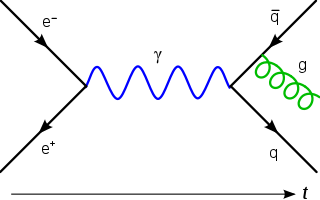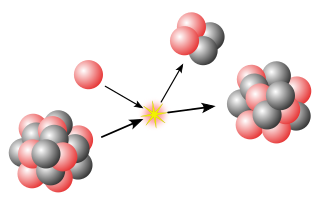Related Research Articles

A gluon is a type of massless elementary particle that mediates the strong interaction between quarks, acting as the exchange particle for the interaction. Gluons are massless vector bosons, thereby having a spin of 1. Through the strong interaction, gluons bind quarks into groups according to quantum chromodynamics (QCD), forming hadrons such as protons and neutrons.

Particle physics or high-energy physics is the study of fundamental particles and forces that constitute matter and radiation. The field also studies combinations of elementary particles up to the scale of protons and neutrons, while the study of combination of protons and neutrons is called nuclear physics.

Brookhaven National Laboratory (BNL) is a United States Department of Energy national laboratory located in Upton, Long Island, a hamlet of the Town of Brookhaven. It was formally established in 1947 at the site of Camp Upton, a former U.S. Army base. Located approximately 60 miles east of New York City, it is managed by Stony Brook University and Battelle Memorial Institute.
ISABELLE was a 200+200 GeV proton–proton colliding beam particle accelerator partially built by the United States government at Brookhaven National Laboratory in Upton, New York, before it was cancelled in July, 1983.
A collider is a type of particle accelerator that brings two opposing particle beams together such that the particles collide. Colliders may either be ring accelerators or linear accelerators.

The Relativistic Heavy Ion Collider is the first and one of only two operating heavy-ion colliders, and the only spin-polarized proton collider ever built. Located at Brookhaven National Laboratory (BNL) in Upton, New York, and used by an international team of researchers, it is the only operating particle collider in the US. By using RHIC to collide ions traveling at relativistic speeds, physicists study the primordial form of matter that existed in the universe shortly after the Big Bang. By colliding spin-polarized protons, the spin structure of the proton is explored.

High-energy nuclear physics studies the behavior of nuclear matter in energy regimes typical of high-energy physics. The primary focus of this field is the study of heavy-ion collisions, as compared to lighter atoms in other particle accelerators. At sufficient collision energies, these types of collisions are theorized to produce the quark–gluon plasma. In peripheral nuclear collisions at high energies one expects to obtain information on the electromagnetic production of leptons and mesons that are not accessible in electron–positron colliders due to their much smaller luminosities.

ALICE is one of nine detector experiments at the Large Hadron Collider at CERN. The experiment is designed to study the conditions that are thought to have existed immediately after the Big Bang by measuring properties of quark-gluon plasma.

The Mainz Microtron, abbreviated MAMI, is a microtron which provides a continuous wave, high intensity, polarized electron beam with an energy up to 1.6 GeV. MAMI is the core of an experimental facility for particle, nuclear and X-ray radiation physics at the Johannes Gutenberg University in Mainz (Germany). It is one of the largest campus-based accelerator facilities for basic research in Europe. The experiments at MAMI are performed by about 200 physicists of many countries organized in international collaborations.
The High Luminosity Large Hadron Collider is an upgrade to the Large Hadron Collider, operated by the European Organization for Nuclear Research (CERN), located at the French-Swiss border near Geneva. From 2011 to 2020, the project was led by Lucio Rossi. In 2020, the lead role was taken up by Oliver Brüning.
A hadron collider is a very large particle accelerator built to test the predictions of various theories in particle physics, high-energy physics or nuclear physics by colliding hadrons. A hadron collider uses tunnels to accelerate, store, and collide two particle beams.

Quark–gluon plasma is an interacting localized assembly of quarks and gluons at thermal and chemical (abundance) equilibrium. The word plasma signals that free color charges are allowed. In a 1987 summary, Léon Van Hove pointed out the equivalence of the three terms: quark gluon plasma, quark matter and a new state of matter. Since the temperature is above the Hagedorn temperature—and thus above the scale of light u,d-quark mass—the pressure exhibits the relativistic Stefan-Boltzmann format governed by temperature to the fourth power and many practically massless quark and gluon constituents. It can be said that QGP emerges to be the new phase of strongly interacting matter which manifests its physical properties in terms of nearly free dynamics of practically massless gluons and quarks. Both quarks and gluons must be present in conditions near chemical (yield) equilibrium with their colour charge open for a new state of matter to be referred to as QGP.

The Low Energy Ion Ring (LEIR) is a particle accelerator at CERN used to accelerate ions from the LINAC 3 to the Proton Synchrotron (PS) to provide ions for collisions within the Large Hadron Collider (LHC).
The polarized targets are used as fixed targets in scattering experiments. In high energy physics they are used to study the nucleon spin structure of simple nucleons like protons, neutrons or deuterons. In deep inelastic scattering the hadron structure is probed with electrons, muons or neutrinos. Using a polarized high energy muon beam, for example, on a fixed target with polarized nucleons it is possible to probe the spin dependent part of the structure functions.
An energy recovery linac (ERL) is a type of linear particle accelerator that provides a beam of electrons used to produce x-rays by synchrotron radiation. First proposed in 1965 the idea gained interest since the early 2000s.

The Large Hadron Electron Collider (LHeC) is an accelerator study for a possible upgrade of the existing LHC storage ring - the currently highest energy proton accelerator operating at CERN in Geneva. By adding to the proton accelerator ring a new electron accelerator, the LHeC would enable the investigation of electron-proton and electron-ion collisions at unprecedented high energies and rate, much higher than had been possible at the electron-proton collider HERA at DESY at Hamburg, which terminated its operation in 2007. The LHeC has therefore a unique program of research, as on the substructure of the proton and nuclei or the physics of the newly discovered Higgs boson. It is an electron–ion collider, similar to the plans in the US and elsewhere, although the present design would not include polarized protons.
Fulvia Pilat is an Italian-American physicist who is currently the Research Accelerator Division Director at the Spallation Neutron Source and an elected fellow of the American Physical Society (APS).

Christine Angela Aidala is an American high-energy nuclear physicist, Alfred P. Sloan Research Fellow and Associate Professor of Physics at the University of Michigan. She studies nucleon structure and parton dynamics in quantum chromodynamics.

Volker D. Burkert is a German physicist, academic and researcher. He is a Principal Staff Scientist at the Thomas Jefferson National Accelerator Facility at Jefferson Lab (JLab) in Newport News, Virginia (USA). He has made major contributions to the design of the CEBAF Large Acceptance Spectrometer (CLAS) that made it suitable for high luminosity operation in experiments studying spin-polarized electron scattering.

Ilan Ben-Zvi is an accelerator physicist and academic. He was the associate chair for accelerator R&D at the Collider-Accelerator Department (C-AD), and is a distinguished scientist emeritus at the Collider-Accelerator Department (C-AD) at Brookhaven National Laboratory.
References
- ↑ A. Accardi et al., "Electron Ion Collider: The Next QCD Frontier – Understanding the glue that binds us all", 2012.
- ↑ "Office of Science" (PDF).
- 1 2 “U.S. Department of Energy Selects Brookhaven National Laboratory to Host Major New Nuclear Physics Facility” 2020.
- ↑ "Brookhaven launches electron-ion collider". 21 September 2020.
- ↑ E. C. Aschenauer et al., “eRHIC Design Study: An Electron–Ion Collider at BNL,” 2014.
- ↑ Abelleira Fernandez, J. L.; Adolphsen, C.; Akay, A. N.; Aksakal, H.; Albacete, J. L.; Alekhin, S.; Allport, P.; Andreev, V.; Appleby, R. B.; Arikan, E.; Armesto, N.; Azuelos, G.; Bai, M.; Barber, D.; Bartels, J.; Behnke, O.; Behr, J.; Belyaev, A. S.; Ben-Zvi, I.; Bernard, N.; Bertolucci, S.; Bettoni, S.; Biswal, S.; Blümlein, J.; Böttcher, H.; Bogacz, A.; Bracco, C.; Brandt, G.; Braun, H.; et al. (2012). "A Large Hadron Electron Collider at CERN Report on the Physics and Design Concepts for Machine and Detector". Journal of Physics G: Nuclear and Particle Physics. 39 (7): 075001. arXiv: 1206.2913 . Bibcode:2012JPhG...39g5001A. doi:10.1088/0954-3899/39/7/075001. S2CID 52498118.
- ↑ "A Large Hadron electron Collider at CERN".
- ↑ "Welcome! | Electron–Ion Collider User Group".
- ↑ Thomas, Will (January 7, 2022). "DOE Nuclear Physics Program Approaches Pivot Point". FYI, American Institute of Physics. Retrieved 15 April 2022.